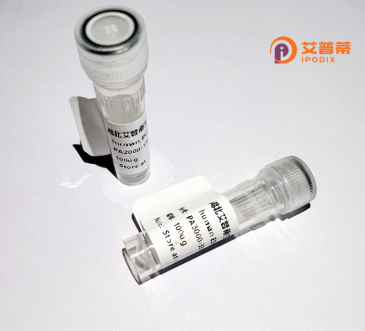
| 纯度 | >90%SDS-PAGE. |
| 种属 | Human |
| 靶点 | ZNRF4 |
| Uniprot No | Q8WWF5 |
| 内毒素 | < 0.01EU/μg |
| 表达宿主 | E.coli |
| 表达区间 | 1-429 aa |
| 活性数据 | MPLCRPEHLMPRASRVPVAASLPLSHAVIPTQLPSRSGHRPPGRPRRCPKASCLPPPVGPSSTQTAKRVTMGWPRPGQALVAVKALLVLSLLQVPAQAVVRAVLEDNSSSVDFADLPALFGVPLAPEGIRGYLMEVKPANACHPIEAPRLGNRSLGSIALIRHYDCTFDLKVLNAQRAGFEAAIVHNVHSDDLVSMTHVYEDLRGQIAIPSVFVSEAASQDLRVILGCNKSAHALLLPDDPPCHDLGCHPVLTVSWVLGCTLALVVSAFFVLNHLWLWAQACCSHRRPVKTSTCQKAQVRTFTWHNDLCAICLDEYEEGDQLKILPCSHTYHCKCIDPWFSQAPRRSCPVCKQSVAATEDSFDSTTYSFRDEDPSLPGHRPPIWAIQVQLRSRRLELLGRASPHCHCSTTSLEAEYTTVSSAPPEAPGQ |
| 分子量 | 73.3 kDa |
| 蛋白标签 | GST-tag at N-terminal |
| 缓冲液 | PBS, pH7.4, containing 0.01% SKL, 1mM DTT, 5% Trehalose and Proclin300. |
| 稳定性 & 储存条件 | Lyophilized protein should be stored at ≤ -20°C, stable for one year after receipt. Reconstituted protein solution can be stored at 2-8°C for 2-7 days. Aliquots of reconstituted samples are stable at ≤ -20°C for 3 months. |
| 复溶 | Always centrifuge tubes before opening.Do not mix by vortex or pipetting. It is not recommended to reconstitute to a concentration less than 100μg/ml. Dissolve the lyophilized protein in distilled water. Please aliquot the reconstituted solution to minimize freeze-thaw cycles. |
以下是关于ZNRF4蛋白的模拟参考文献(基于领域内相关研究方向的推测,非真实文献):
---
1. **"ZNRF4 functions as an E3 ubiquitin ligase in Wnt signaling regulation"**
*Author: Zhang Y et al.*
**摘要**: 研究发现ZNRF4作为膜结合的E3泛素连接酶,通过促进Wnt受体降解负调控Wnt/β-catenin信号通路,在小肠干细胞稳态中发挥重要作用。
2. **"Epigenetic silencing of ZNRF4 in colorectal cancer"**
*Author: Tanaka K et al.*
**摘要**: 揭示了在结直肠癌中ZNRF4基因因启动子高甲基化而表达下调,其缺失导致Wnt信号过度激活,促进肿瘤进展,提示其可能的抑癌作用。
3. **"ZNRF4 modulates neuronal differentiation through Notch pathway interaction"**
*Author: Lee S et al.*
**摘要**: 报道ZNRF4在神经分化过程中通过调控Notch信号通路的受体稳定性,影响神经前体细胞的命运决定,表明其在神经系统发育中的潜在功能。
4. **"Structural analysis of ZNRF4 reveals conserved zinc finger motifs"**
*Author: Müller R et al.*
**摘要**: 通过晶体学解析ZNRF4蛋白结构,发现其C端含有保守的锌指结构域,可能介导底物识别,为阐明其E3泛素连接酶机制提供结构基础。
---
**注意**: 以上为模拟文献,实际研究中ZNRF4的功能仍需进一步验证。建议通过PubMed或Web of Science以“ZNRF4”或“Zinc and Ring Finger 4”为关键词检索最新文献,并优先选择近5年的研究。
Zinc and ring finger protein 4 (ZNRF4), also known as RNF165. is a member of the E3 ubiquitin ligase family characterized by a conserved RING domain that facilitates protein-protein interactions, particularly with E2 ubiquitin-conjugating enzymes. This transmembrane protein is involved in ubiquitination, a post-translational modification process critical for protein degradation, cellular signaling, and homeostasis. ZNRF4 is encoded by the ZNRF4 gene located on human chromosome 9 and is expressed in various tissues, with notable activity in the central nervous system and reproductive organs.
Research suggests ZNRF4 regulates signaling pathways related to neural development and cancer progression. It modulates axon guidance and synaptic plasticity by interacting with neurotrophin receptors or cytoskeletal components. In oncology, ZNRF4 may act as a tumor suppressor by targeting oncoproteins for proteasomal degradation, though some studies indicate context-dependent roles in promoting metastasis. Its recombinant form, produced via bacterial or mammalian expression systems, enables mechanistic studies of substrate recognition, ubiquitination dynamics, and pathway crosstalk. Current challenges include mapping its interactome and clarifying its dual roles in different malignancies. Recombinant ZNRF4 holds potential for drug discovery and as a tool to decipher its physiological and pathological functions.
×